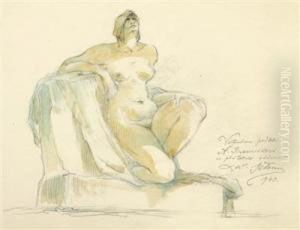Ladislav Saloun Paintings
Ladislav Šaloun was a prominent Czech sculptor, primarily known for his Art Nouveau and Symbolist works. He was born on August 1, 1870, in Prague, which at the time was part of the Austro-Hungarian Empire and is now the capital of the Czech Republic. Šaloun is most famous for his public monuments and memorials that combine nationalistic themes with a modern, fin de siècle sensibility.
Šaloun's education in the arts began at the School of Applied Arts in Prague, and he further honed his skills at the Academy of Fine Arts in Prague. His travels to Paris also had a significant influence on his artistic development, exposing him to the vibrant art scene and the emerging Art Nouveau movement. He was deeply inspired by the works of French sculptor Auguste Rodin, and this influence is evident in the dynamic forms and emotional expressiveness of Šaloun's sculptures.
Perhaps the most famous work by Ladislav Šaloun is the Jan Hus Memorial in Prague's Old Town Square, unveiled in 1915 to commemorate the 500th anniversary of the reformer's death. The monument is a powerful symbol of Czech nationalism and a masterpiece of Art Nouveau sculpture. It features a prominent statue of Hus, surrounded by groups of figures representing both the oppression of the Czech people and their struggle for independence and reformation.
In addition to the Jan Hus Memorial, Šaloun produced a number of other significant works, including a statue of the mythical Princess Libuše, which became part of the Vyšehrad National Cultural Monument. He also designed numerous tombstones and funerary monuments, bringing his distinctive style to the realm of personal memorials.
Šaloun's contributions to Czech art were not limited to his sculptural works. He also played an important role in the cultural life of Prague and was a member of various artistic societies. His influence extended to teaching, where he nurtured the next generation of Czech sculptors, ensuring the continuation of his artistic legacy.
Ladislav Šaloun's career was a reflection of the turbulent times he lived through, including the First World War and the subsequent establishment of Czechoslovakia as an independent nation. His works often embodied the national pride and resilience of the Czech people. He continued to work until his death on October 18, 1946, in Prague. His legacy is preserved in the many sculptures and monuments that adorn the Czech landscape, serving as enduring symbols of both artistic beauty and national identity.
